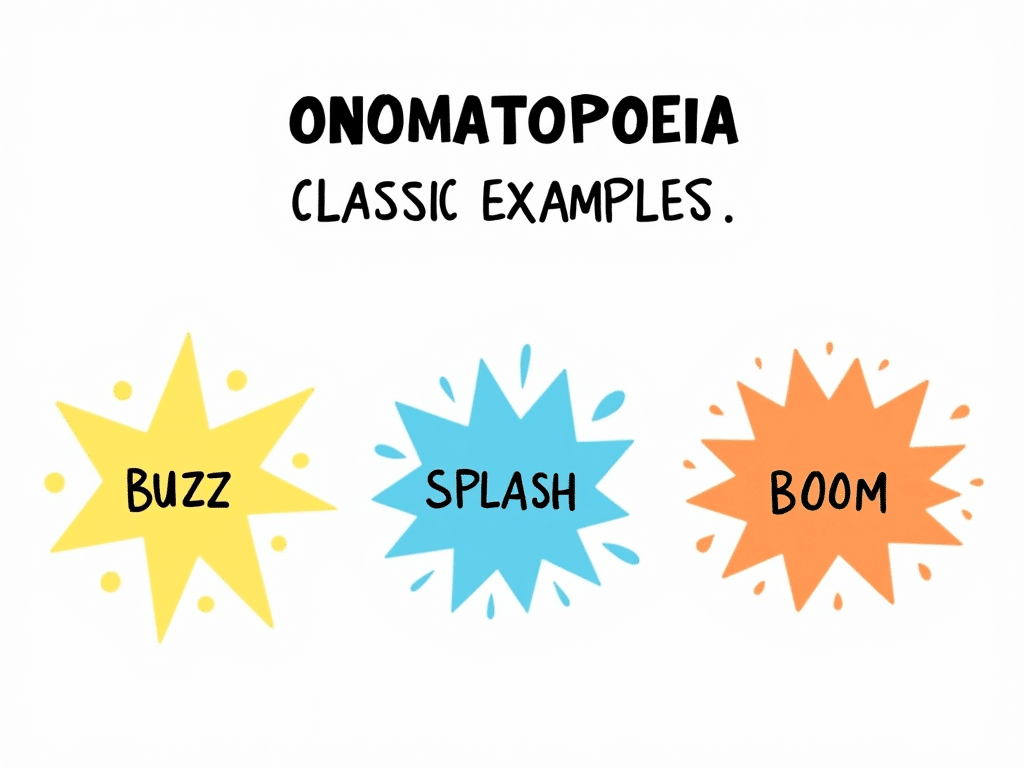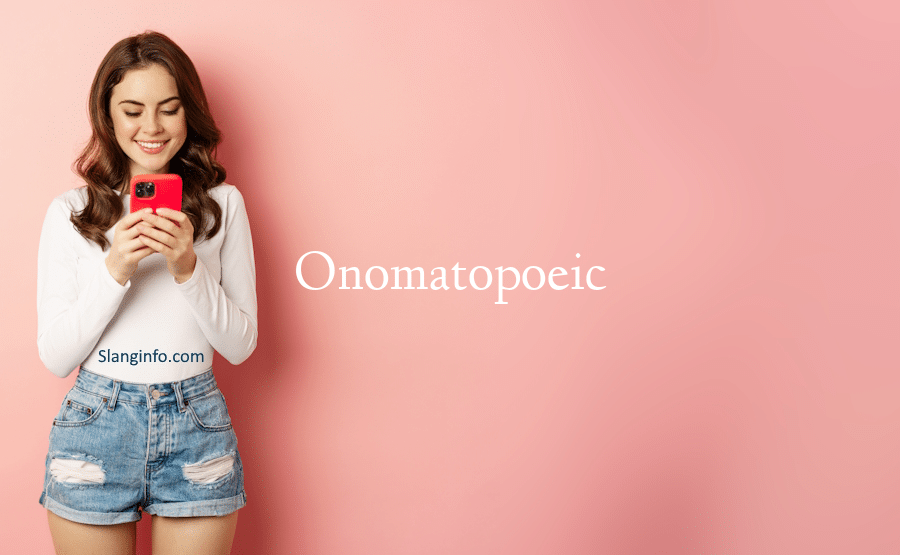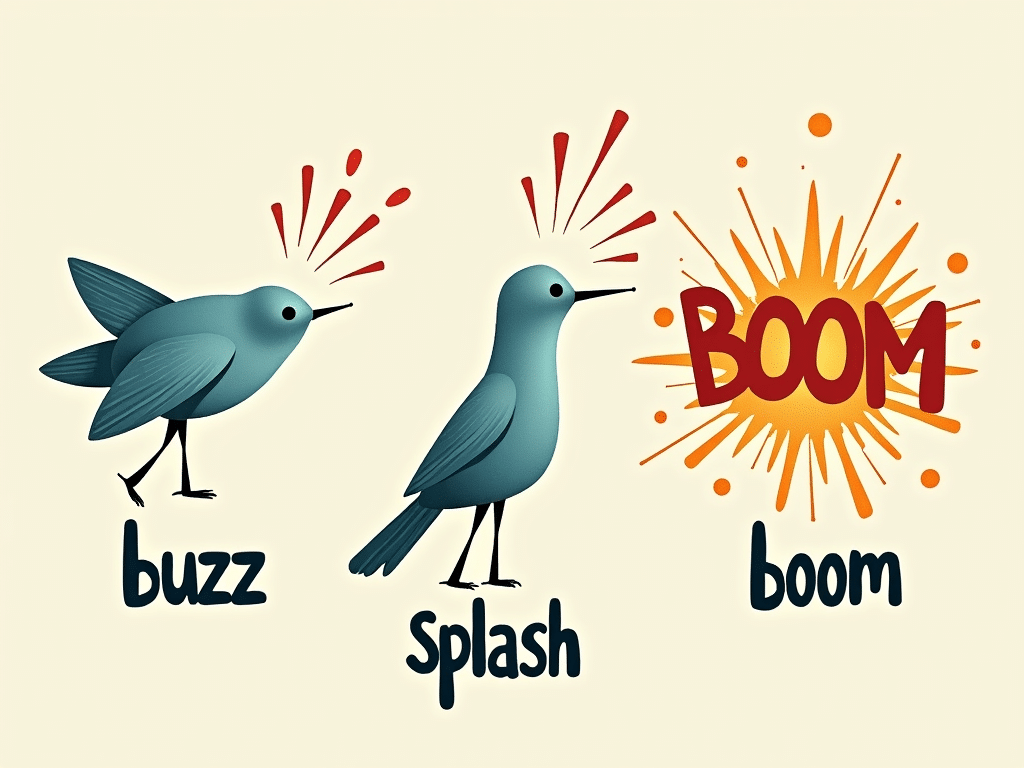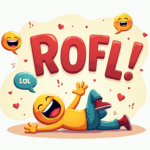Ever wondered why comic books are filled with words like “POW!”, “BANG!”, and “ZOOM!”? Well, my friend, you’ve just stumbled into the wild world of onomatopoeia! These words aren’t just random gibberish – they’re carefully crafted to make you hear the action with your eyes. Cool, right? 😎
| Key Takeaways |
|---|
| 1. Onomatopoeia = words that sound like what they describe |
| 2. Used in literature, comics, and everyday speech |
| 3. Varies across languages and cultures |
| 4. Makes writing more vivid and engaging |
| 5. Common in animal sounds and sound effects |

What’s the Deal with Onomatopoeia?
Okay, let’s break it down. Onomatopoeia (on-uh-mat-uh-PEE-uh) is when a word sounds like the noise it’s describing. It’s like your mouth is trying to be a sound effects machine!
For example, when you say “buzz,” your mouth is actually mimicking the sound a bee makes. Pretty neat, huh? It’s like verbal cosplay for sounds!
Types of Onomatopoeia: Not All “Booms” Are Created Equal
Believe it or not, there are different flavors of onomatopoeia. Let’s check ’em out:
- Direct Onomatopoeia: These are the straightforward sound mimickers.
- Examples: hiss 🐍, boom 💥, splash 💦
- Associative Onomatopoeia: These words don’t exactly sound like what they describe, but they give you a feeling of the sound.
- Examples: glimmer ✨, twinkle 🌟, flutter 🦋
- Exemplary Onomatopoeia: These are words that come from the sound an animal or thing makes.
- Examples: cuckoo (from the bird’s call), yeet (from the sound of throwing something)
Onomatopoeia: The Language Chameleon

Here’s where it gets really wild – onomatopoeia changes depending on where you are in the world! It’s like each language has its own set of ears.
Check out how different languages hear a dog bark:
- English: “woof” or “bark”
- Japanese: “wan”
- Spanish: “guau”
And a cat’s meow:
- English: “meow”
- Japanese: “nyan”
- French: “miaou”
It’s like a global game of telephone, but with animal sounds!
Onomatopoeia in Literature: Making Words Pop Off the Page
Writers love onomatopoeia because it makes their words come alive. It’s like adding a soundtrack to your reading experience.
Take Edgar Allan Poe’s poem “The Bells.” He uses words like “tinkle,” “jingling,” and “clanging” to make you feel like you’re surrounded by bells of all sizes. It’s almost like you can hear the poem, not just read it!
Or think about Dr. Seuss books. They’re packed with made-up onomatopoeic words that make reading fun and silly. “The zummer is coming, the zummer is near!” from “Oh, the Thinks You Can Think!” It doesn’t make logical sense, but you can totally hear that “zummer” buzzing, can’t you?
Onomatopoeia in Pop Culture: From Comics to Catchphrases
Onomatopoeia is everywhere in pop culture. It’s like the ninja of the word world – always there, but often unnoticed.
- Comics: Where would Batman be without his “POW!” and “BAM!”? These sound effects make the action jump off the page.
- Advertising: Ever wonder why Rice Krispies went with “Snap! Crackle! Pop!”? It’s onomatopoeia making your breakfast sound exciting!
- Music: Songs like “Boom Boom Pow” by The Black Eyed Peas or “Tik Tok” by Kesha use onomatopoeia to create catchy, memorable hooks.
Onomatopoeia in Everyday Life: You’re Already Using It!
Believe it or not, you’re probably using onomatopoeia way more often than you realize. It’s like a secret language we all speak without even knowing it. Here are some everyday examples:
- When you text your fam “haha” or “lmao” instead of saying “that’s funny”
- Saying “achoo” when you sneeze (fun fact: sneezes sound different in other languages!)
- Using “tick-tock” to describe time passing slowly
It’s like our brains are hardwired to turn sounds into words. Pretty cool, right?
The Power of Onomatopoeia: Why It Matters
Now, you might be thinking, “Okay, this is fun and all, but why should I care?” Well, my friend, onomatopoeia is like a secret weapon for communication. Here’s why:
- It makes language more vivid: Instead of saying “the car was loud,” you can say “the car vroomed down the street.” Suddenly, you can almost hear that car, can’t you?
- It’s universal: Even if you don’t speak the same language, onomatopoeia can help you communicate. Make a “moo” sound anywhere in the world, and people will probably think of a cow.
- It’s fun: Let’s face it, saying “kaboom” is way more entertaining than saying “explosion.” It’s like adding sound effects to your speech!
- It helps with memory: Words that sound like what they describe are often easier to remember. It’s like your brain gets a little audio cue along with the word.
Onomatopoeia in the Digital Age: From Bruh to Yeet
The internet and social media have given onomatopoeia a whole new playground. We’re creating new sound-words faster than ever:
- “Sksksk” to represent excited laughter or keyboard smashing
- “Yeet” for the sound of throwing something with force
- “Oof” for when something painful or awkward happens
It’s like we’re all contributing to this ever-growing dictionary of sound-words. How cool is that?
Conclusion: The Sound of Language
So there you have it, folks! Onomatopoeia isn’t just some fancy word you learn in English class. It’s a living, breathing part of language that we use every day. It’s in our books, our music, our memes, and our everyday conversations.
Next time you hear someone say “bruh” or see a comic book “KAPOW!”, take a moment to appreciate the awesome power of onomatopoeia. It’s making our language richer, more expressive, and way more fun.
And hey, why not try creating your own onomatopoeic words? Who knows, maybe your creation will be the next big thing in Gen Z slang!
Remember, language is alive, and onomatopoeia is one of the ways it keeps growing and changing. So go forth and make some noise with your words! BOOM! 💥







